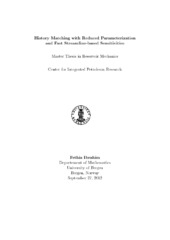| dc.description.abstract | The main goal of history matching is to construct updated models capable of predicting the future performance of the reservoir more accurately. History matching method requires a solution of inverse problem to minimize the objective function. The main idea of the inverse problem is to find model parameters that best match to the production data. An inverse problem is said to be well-posed if stable and unique solution exists, else the problem is said to be ill-posed. Typically history matching is an ill-posed problem, for which non-unique solution exists. Therefore, regularization by parameterization is applied in this thesis to reduce the number of unknown parameters in order to alleviate the problem of ill-posedness. The parameterization includes two aspects: the parameterization structure determined by the set of bases functions and the corresponding coefficients embedded in the structure. Stepwise estimation strategy of parameterization structure is used to sequentially find new parameterization structure that leads to large decrease in the objective function. There are different approaches that can be used to integrate the geological model to production data. These include amplitude matching, time inversion and generalized travel time inversion (GTTI). GTTI is used in this thesis as it merges the travel time matching with the amplitude matching, in such a way that, it preserves the quasi-linear properties of travel time inversion while using the overall production data. In history matching, different optimization algorithms are applied to minimize the objective function. Levenberg-Marquard optimization method is used in this thesis. It is Guass-newton method with a trust region strategy and modified by adding positive term. The work in this thesis is based on the implementation in [1] and extended using the idea that are presented in [5]. Then the parameterization method is compared with standard method both in the ability to reduce the objective function and in characterizing the permeability field. Simulation results illustrated that the parameterization method showed better performance in reducing the objective function and in characterizing the permeability field for simple cases. But for last case the method did not performed well. | en_US |
